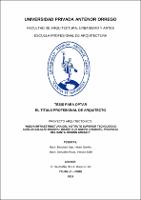Mostrar el registro sencillo del ítem
Nueva infraestructura del Instituto Superior Tecnológico Carlos Salazar Romero, distrito de Nuevo Chimbote, provincia del Santa, Región Ancash
| dc.contributor.advisor | Saldaña Milla, Roberto Helí | |
| dc.contributor.author | Bendezú Vigo, Hitomi Sumiko | |
| dc.contributor.author | Gonzales Rivas, Yessica Edith | |
| dc.creator | Bendezú Vigo, Hitomi Sumiko | |
| dc.date.accessioned | 2019-06-20T19:31:14Z | |
| dc.date.available | 2019-06-20T19:31:14Z | |
| dc.date.issued | 2019 | |
| dc.identifier.uri | https://hdl.handle.net/20.500.12759/4966 | |
| dc.description.abstract | Durante los últimos años, nos hemos visto enfrentados a numerosos cambios que han ido modificando la manera de entender el rol de la educación en nuestra sociedad y cómo influye el rol arquitectónico en la vida académica del estudiante, por ejemplo el país vecino de Chile, se encuentra en un proceso de apertura y búsqueda de igualdad de oportunidades, en donde los estudiantes, docentes, padres de familia, personal administrativo y personal de limpieza, encuentran mejoras en su trabajo, creciendo todos ellos juntos para potenciar la formación integral de cada uno de sus estudiantes. El Ministerio de Educación ha asumido el desafío de lograr que todos nuestros estudiantes puedan acceder a una educación de calidad, fortaleciendo el espacio donde se realizan los procesos de formación académica. Ahora ¿Cómo podemos dar respuesta a los cambios a través de la infraestructura educativa? Y ¿Cómo deberían ser nuestros espacios educativos? Hoy en día existe una gran conciencia acerca del importante rol que ha ocupado el concepto de espacio educativo por sobre la infraestructura, siendo la escuela un sistema complejo de relaciones en donde se tiene que responder a las necesidades del proyecto educativo, teniendo como elementos indispensables la sociedad y el entorno cultural. Es por ello, que los espacios educativos y los diversos elementos que lo componen constituyen la atmosfera y el escenario en donde el proceso pedagógico se lleva a cabo, eliminando por completo la conceptualización del aula rígida y fría, teniendo como nuevo concepto al aula como un espacio flexible y dinámico que facilite la interacción entre el espacio exterior y el interior. Asimismo, se ha eliminado la conceptualización de espacios educativos como elementos rígidos y fríos, que estaban constituidos por pabellones, sin la presencia del elemento arquitectónico como diseño formal, espacial y tecnológico. Pues bien, son estas expectativas que se han tomado en cuenta para el nuevo diseño formal del INSTITUTO TECNOLÓGICO CARLOS SALAZAR ROMERO. | es_PE |
| dc.description.abstract | In the last few years, we have seen a lot of changes in the way we understand the education in our society and how the architecture influences in the academic life of the students, for example, our neighboring country of Chile is searching equal opportunities where the students, teachers, parents and human resources can find improvements in their work, growing up together for enhance an integral education for the students. The ministry of education has assumed the challange of give all students the access to an education of quiality by improving the space where academic training takes place. How can we answer to the changes through the infrastrcucture? And how our educational environment should be? Today there is a greater awareness about the importance of educational environment concept in the infrastructures being the school a complex sistem of relationships where it is needed to respond to the needs of the educational project, being indispensable the society and the cultural environment . It is therefore that te educational evironment and the various elements that composes it, constitute the environment andd the scenary where te pedagogic process takes place, eliminating completely the conceptualization of rigid and cold calssroom, giving place for the new concept of flexible and dinamic environment for classrooms to facilitate the interaction between the inside and outside. It has also been eleminated the conceptualization of educational espaaces like rigid and cold elements, that was constitute by pavilions without the presences of architectural elements like formal design, space and technology. Those are the parameters that has been taken for the new formal design of the INSTITUTO TECNOLOGICO CARLOS SALAZAR ROMERO. | en_US |
| dc.description.uri | Tesis | es_PE |
| dc.format | application/pdf | es_PE |
| dc.language.iso | spa | es_PE |
| dc.publisher | Universidad Privada Antenor Orrego - UPAO | es_PE |
| dc.relation.ispartofseries | MEM_ARQ_502 | |
| dc.rights | info:eu-repo/semantics/closedAccess | es_PE |
| dc.source | Universidad Privada Antenor Orrego | es_PE |
| dc.source | Repositorio Institucional - UPAO | es_PE |
| dc.subject | Formación académica | es_PE |
| dc.subject | Infraestructura educativa | es_PE |
| dc.subject | Espacios educativos | es_PE |
| dc.subject | Espacio flexible | es_PE |
| dc.title | Nueva infraestructura del Instituto Superior Tecnológico Carlos Salazar Romero, distrito de Nuevo Chimbote, provincia del Santa, Región Ancash | es_PE |
| dc.type | info:eu-repo/semantics/bachelorThesis | es_PE |
| thesis.degree.level | Título Profesional | es_PE |
| thesis.degree.grantor | Universidad Privada Antenor Orrego. Facultad de Arquitectura, Urbanismo y Artes | es_PE |
| thesis.degree.name | Arquitecto | es_PE |
| thesis.degree.discipline | Arquitectura | es_PE |
Ficheros en el ítem
Este ítem aparece en la(s) siguiente(s) colección(es)
-
Arquitectura [415]

